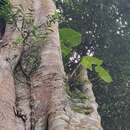ar
الأسماء في صفحات التنقل


Remusatia vivipara also called hitchhiker elephant ear is a perennial herb growing up to 50 cm tall in the genus Remusatia. It is widespread throughout the world, growing in temperate climates.
Remusatia vivipara is a rupicolous or epiphytic herb that grows up to 50 cm tall, arising from an underground tuber around 2–4 cm in diameter and coloured vivid red. Its bulbils are scaly and ovoid, around 5 mm long, scales ending in hooked prickles. The leaf is solitary, is broad and peltate, 10–40 cm long and 5–30 cm across, with a petiole up to 40 cm long. R.vivipara very rarely flowers. Spathe is leathery, 10–13 cm long with an ovoid tube which is green. Spadix is around 3.5 cm long, clavate and creamy white with the flowers unisexual and congested, female at base, male at tip, separated by sterile flowers in the middle.[2] Fruits a cluster of berries.[3]
Remusatia vivipara can be found in Central and Western Africa, from Tanzania and Ethiopia to Sierra Leone; Oman, Yemen, Taiwan, Tibet, Yunnan, India, Indochina, Java and Northern Australia.[4] Remusatia viviparais can be found in subtropical forests, on rocks, cliff edges around 700m-1900m above sea level. It is epiphytic in leaf litter traps on large trees such as Ficus vasta.[5]
It rarely flowers in Asia, whilst in Africa it never flowers and there are no observations of Remusatia vivipara flowering in Arabia. However, the small bulbils that appear on the plant are readily detached and can be carried hundreds of kilometres by clinging to the feathers of birds. This accounts for the wide distribution of the species.[6]
Tubers are edible when cooked very thoroughly either by roasting or boiling to deactivate the oxalate crystals. They are eaten in Dhofar with clarified butter or buttermilk and eaten in India added to curries.[7]
Remusatia vivipara also called hitchhiker elephant ear is a perennial herb growing up to 50 cm tall in the genus Remusatia. It is widespread throughout the world, growing in temperate climates.
Ráy mô (danh pháp khoa học: Remusatia vivipara) là một loài thực vật có hoa trong họ Ráy (Araceae). Loài này được (Roxb.) Schott miêu tả khoa học đầu tiên năm 1832.[1]
Ráy mô (danh pháp khoa học: Remusatia vivipara) là một loài thực vật có hoa trong họ Ráy (Araceae). Loài này được (Roxb.) Schott miêu tả khoa học đầu tiên năm 1832.
岩芋(学名:Remusatia vivipara)是天南星科岩芋属的植物。分布在印度锡金、泰国、喀麦隆、印度尼西亚爪哇、尼泊尔、越南、斯里兰卡、缅甸、印度东北以及中国大陆云南南部至东南部等地,生长于海拔200米至1,900米的地区,常生长在河谷疏林以及灌丛中的岩石上,目前尚未由人工引种栽培。[1]
臺灣分布在南投及屏東山區,附於樹幹的草本植物,葉子呈卵形,約2至3片狀[5][3]。因其種子缺少胚乳,臺灣與原生地並不相似而種子不易萌發,常常藉由鱗莖珠芽(bulbil)行「無性生殖」,染色體為「三倍體」,遺傳基因與南投縣信義鄉雙龍部落的零星「雲南岩芋」(Remusatia yunnanensis)幾乎完全相似,「雲南岩芋」染色體則為「二倍體」。[6]
红芋、红半夏、红岩芋(云南思茅) 红天椒(云南富宁) 红芋头(云南马关) “哈怕都姆”(傣族语)
|access-date=中的日期值 (帮助) |access-date=中的日期值 (帮助)
岩芋(学名:Remusatia vivipara)是天南星科岩芋属的植物。分布在印度锡金、泰国、喀麦隆、印度尼西亚爪哇、尼泊尔、越南、斯里兰卡、缅甸、印度东北以及中国大陆云南南部至东南部等地,生长于海拔200米至1,900米的地区,常生长在河谷疏林以及灌丛中的岩石上,目前尚未由人工引种栽培。
臺灣分布在南投及屏東山區,附於樹幹的草本植物,葉子呈卵形,約2至3片狀。因其種子缺少胚乳,臺灣與原生地並不相似而種子不易萌發,常常藉由鱗莖珠芽(bulbil)行「無性生殖」,染色體為「三倍體」,遺傳基因與南投縣信義鄉雙龍部落的零星「雲南岩芋」(Remusatia yunnanensis)幾乎完全相似,「雲南岩芋」染色體則為「二倍體」。